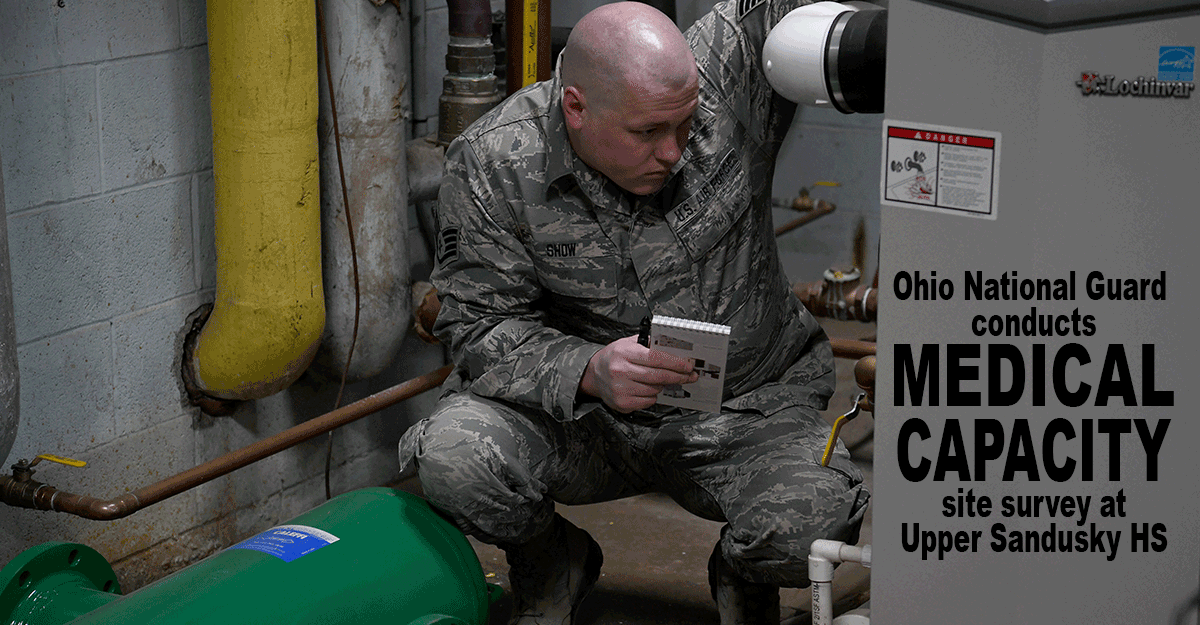Ohio National Guard’s Joint Engineer Assessment Teams evaluating potential alternate medical care facilities
Story by Tech. Sgt. Shane Hughes, Ohio National Guard Public Affairs
UPPER SANDUSKY, Ohio (04/07/20)
Ohio Gov. Mike DeWine turned to the Ohio National Guard to support the state in developing a crucial plan that would expand medical capacity as Ohio’s health care systems brace for the looming COVID-19 peak.
The Ohio National Guard’s response? A regional approach supporting state agencies aimed at one goal — identifying alternate care sites that are beyond what would traditionally be considered medical facilities. Soldiers and Airmen who specialize in engineering and construction are supporting this effort by using their military and civilian expertise to find the best possible solutions for Ohio.
Based on the five geographical Ohio Emergency Management Agency-designated regions in the state, the Joint Engineer Assessment Teams, or JEATs, are a collaboration between the Ohio Department of Health, Ohio EMA, Ohio National Guard and regional officials that are tackling Ohio’s medical facility capacity concerns before they become a problem that the state’s existing health care infrastructure cannot manage. Sites being considered include unused state-owned facilities, convention centers, large commercial properties and academic sites.
One of the JEATs visited Upper Sandusky High School April 4 to evaluate the site as a potential alternate medical care facility to treat overflow patients from regional hospitals during the COVID-19 pandemic, should the anticipated need become a reality.
“We don’t know how many patients we’re going to see come down with COVID-19 in the next few weeks,” said Valerie Schalk, vice president of operations and chief nursing officer for Wyandot Memorial Hospital, located in Upper Sandusky. “We have to be prepared for the worst-case scenario.”
Each regional JEAT evaluation is part of a proactive, whole-of-government approach to expanding medical capacity in anticipation of the projected COVID-19 peak, so that hospitals are prepared for a surge in patients and their critical medical staff can continue to provide life-saving care.
“This is an Ohio mission and everyone involved brings a specific skill set and a different way of looking at things to the team,” said Army Maj. Brett Green, the team leader for Northwest Ohio. “One of our Air Force guys is an electrical engineer and on the Army side I have a civil engineer. We’re bringing the talent pool together to help the people of Ohio.”
Army Capt. Tim Cope, an engineer adviser for the Northwest Ohio JEAT, agreed. “Every member of this team was selected because they have unique skills and expertise they bring to this mission,” he said. “We’re leveraging their civilian expertise, and that’s something you don’t get from active-duty components.”
Cope said his team is evaluating how many beds a facility can support, electrical capacity for nursing stations and medical equipment, availability of outdoor space for medical screenings of potential COVID-19 cases, full-service kitchen facilities to prepare meals for staff and patients, access to showers and restrooms, internet capabilities and many other considerations.
The school is just one of seven sites being considered for the Northwest Ohio region. Because schools are temporarily closed and provide access to many of these resources, they are potentially ideal sites for alternate care facilities. Schalk said the school’s proximity to the hospital was also one of the primary reasons it was being considered as an alternate care facility. The school is also located near major highways, which makes it easier for other hospitals to transport patients to the site.
“Based on the Ohio Department of Health’s predictions, we should be able to handle at least three times our capacity at the hospital, but if it goes past that, this would be a secondary site for us to treat patients,” said Ty Shaull, chief executive officer for Wyandot Memorial Hospital.
Shaull said the site would most likely be used for patients who do not have COVID-19, to relieve pressure on the hospital and free up resources for patients in need of critical care, but it could also be used for patients whose symptoms are not severe or for patients in recovery.
Once the JEAT has completed its site evaluations, Green said he will send reports to be reviewed by the governor and other state officials who will make the final decision on which locations are best suited for the anticipated needs of the region.
The governor announced during an April 6 press conference that six initial alternate care sites had been selected, based upon the assessments of the JEATs: SeaGate Convention Centre, Lucas County; Case Western University’s Health Education Campus, Cuyahoga County; Dayton Convention Center, Montgomery County; Covelli Centre, Mahoning County; Duke Energy Convention Center, Hamilton County; and Greater Columbus Convention Center, Franklin County.
Green said the time it takes to make a site fully operational will vary on the scope of care the site is expected to provide, but the plan is to have the first sites operational by mid-April.
“It’s a tough mission against an unseen enemy, but we’re ready,” Green said. “Ultimately, we really hope that we never have use these sites.”
